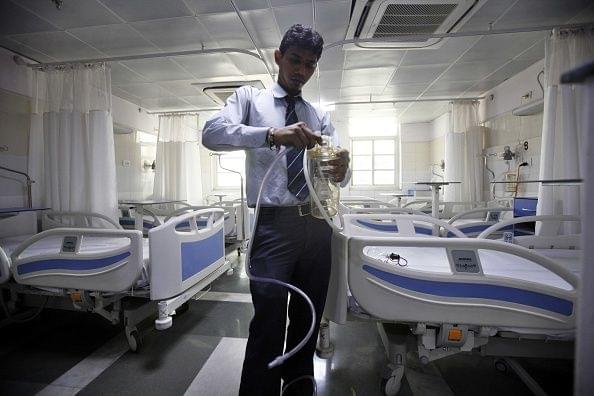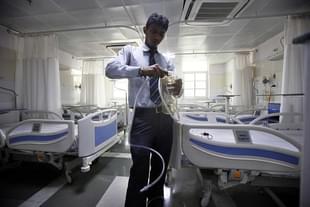Ideas
Why Rising Healthcare Cost Has Little To Do With Ayushman Bharat Or Data Error
Saket Hishikar
Feb 05, 2019, 02:36 PM | Updated 02:32 PM IST
Save & read from anywhere!
Bookmark stories for easy access on any device or the Swarajya app.


The January Consumer Price Index or CPI (combined) press release shows two interesting facts – one, an overall price deceleration in basket of goods and services tracked by the index and second, the curious case of acceleration in health inflation. The latter which accounts for 5.89 per cent weight in the index is not of much consequence for the overall change in the index but is nevertheless important because high health cost can derail the poverty alleviation efforts, particularly for those household at the margins.
The sudden rise in the health care cost in the CPI basket has been attempted to be explained in multiple ways. The explanations fall under three categories, namely: higher input cost of medicine, price effect of Ayushman Bharat and possible data errors at the compilation stage of the CPI. However, none of these somehow explain the sudden jump in CPI health inflation.
This write-up is not about debating the three possible causal factors but about looking at the nuances of price formation in India’s health sector. The lack of serious engagement with these critical nuances often leads to speculations in all directions.
Topology Of India’s Health Sector
India’s health sector is a complex market comprising of doctors with private practice (allopathy and other methods) and working for organised establishments, such as government and private hospitals, nursing homes and super-speciality hospitals.
However, the predominant supply of health services comes from private doctors. This leads to an important distinction between institutional and non-institutional medical expenses i.e. whether the expenses were incurred on medical treatment as an in-patient at a medical institution (institutional), or otherwise (non-institutional).
Medicine accounts for nearly 80 per cent of non-institutional medical expenses in rural India and 75 per cent in urban India (NSS 68th Round). The second most important expense is the doctor’s fees. As non-institutional medical expenditure dominates both rural and urban areas, the medicines prescribed (branded or generic) by the local doctor in response to patterns and incidences of diseases decides the demand of drug and hence the price formation of medicines.
An itemised look at CPI health basket shows that medicine (non-institutional) has the highest weight. Moreover, it is the expenses in non-institutional category that dominates the CPI health basket. Thus from this point of view, CPI health inflation can actually be considered to be non-institutional health cost inflation.
Therefore, as a preliminary remark, we can safely rule out the impact of Ayushman Bharat scheme as a reason for health cost inflation because it comes strictly under the institutional category. Since, the scheme has just come into operation; it is unlikely that it will change the ratio of institutional to non-institutional expenditure in such a short time across all states (some states are yet to adopt the scheme).
Furthermore, treatment under cardiology is the most sought after under the scheme wherein drugs used for treatment (such as for blood pressure, diabetes and anti-cholesterol atorvastatin) are under the national list of essential medicines (NLEM) and hence available at a lower cost. Also the price of stents has been capped by the government.
The Drug Categories In India
Since medicines carry the largest weight in the CPI health index, it is essential to deliberate on the topology of this sub-segment of the health sector and how it impacts the relative prices.
The topology of the drug sector can be visualised through four different classifications. They are:
- NLEM/non-NLEM category
- Scheduled/non-scheduled category
- Old/new category
- Acute therapy drug/chronic therapy drug
These classifications are not mutually exclusive and can be overlapping. For instance, since 2013, all essential medicines (as defined under NLEM) are treated as scheduled formulations. Each category has its own dynamics of price formation in the broader sense and can get complicated if medicine is sold in combinations consisting of NLEM and non-NLEM molecule.
The NLEM category drug consists of only 12 per cent of the total drug produced. Thus 88 per cent of the drug is outside the essential list of medication.
The second classification of drug – scheduled and non-scheduled – is based on the potential for substance abuse. There is no pricing control on non-schedule drugs but the manufacturers are allowed to increase the maximum retail price by 10 per cent annually. In that sense, while essential medicines are subject to absolute price controls in the form of ceiling prices, the non-essential or non-scheduled medicines are subject to a managed price increase or a ceiling on price changes.
The third classification of drugs is based on the introduction of new drugs into the market. The term ‘new drug’ can mean two different things. First, it could refer to a formulation launched by an existing manufacturer of a drug of specified dosages and strengths as listed in the NLEM by combining the drug with another drug either listed or not listed in the NLEM. Or else, it could be a formulation launched by changing the strength or dosages or both, of the same drug as listed in the NLEM.
The price to retailer of a new drug of this type is fixed by the government with 16 per cent margin on the principles of ‘pharmaco-economics’ and the recommendation of a standing committee of experts. Second, a new drug could also mean a new formulation which is under patent, and which would be exempted from the application of price control for the first five years, since the commencement of commercial production.
The final classification is based on acute diseases and chronic diseases and is also used by the industry to track drug sales. Shifts in mix of drug sales across months can have a bearing on relative prices. The Pharma Trac data since 2018 is indicating that domestic sales have been driven by the chronic segment. Even in November, the acute segment pulled down the total sales in the pharma sector.
Price Formation In Health Sector
Based on the above discussion, it is clear that price formation in the drug segment, is a complex nexus of various factors in the non-institutional segment. The price of a drug is decided by many factors such as its classification, changes in incidences of diseases (chronic vs acute), launch of new/patented drugs and above all on the discretion of doctors.
Furthermore, only massive shifts in demand or price shock to key inputs can have a bearing on price formation from a pure economic side. Since shifts in demand are not possible in a short time, this leaves us with the only option of exploring the input supply angle.
Before we do the analysis of cost structure of drugs, it is pertinent to mention that cost of health can be measured through both CPI and WPI (a wholesale price index). While CPI basket uses the institutional/non-institutional classification, the WPI is constructed approximately on chronic/acute therapy classification of drugs. Thus, it is difficult to measure the transmission of WPI to CPI and strictly speaking there is no one-to-one correspondence. Further, both CPI and WPI include medical devices where import dependency is approximately 75 per cent.
The cost structure of the drug segment is not easy to construct as it depends on individual firm specific factors and the molecule(s) used.
However, RBI is now regularly publishing KLEMS data base which gives long series on the input structure of various industry segments. Taking chemicals and chemical products as proxy for drug industry, the annual changes in cost of drugs can be gauged with reasonable accuracy. This exercise is done in the table below for the month of November as all the proxies do not have the same history.
Source: RBI, CSO, MOSPI, Authors calculations
Based on these calculations, let us now look at the real reasons which led to health cost inflation. The calculations show that it is indeed the total cost of production of drug as per cent of output that increased approximately by 7.1 per cent in November on a year on year basis. The highest increase in the cost of production happened due to the increase in the price of energy and exchange rate depreciation. The material inputs were the largest component of the total input and it included API, organic and inorganic chemicals.
The second big reason for the health cost inflation was also the excessive dependence of drug manufacturers on Chinese imports. The National Security Advisor had also hinted at the same in 2014. This dependency on Chinese imports is close to 80 per cent, which is jacking up the drug prices. This is further compounded by the fact that the medical devices component also has an import dependency of 75 per cent as noted above.
It is no wonder that the medicine component of CPI and overall CPI health, registered a sharp growth after October, indicating a lagged effect of exchange rate depreciation and high energy prices. It is not Ayushman Bharat or data errors but these reasons which explain the inflation beyond mere speculation.
The inability of the National Pharmaceutical Pricing Authority (NPPA) to properly track the cost structure of the drugs under NLEM and otherwise, imposes serious limitations on its ability to ensure affordable drug prices. NPPAs present method of ascertaining the price ceiling is independent of the cost structure of the manufacturers. This limitation also hampers the orderly development of the industry as there is no link between the practicality of manufacturing and ultimate price regulation.
The discussion in this study shows how one can track the cost structure by using radially available data. However, it is necessary that a more granular study is conducted, possibly based on the different classifications explained above. The recently constituted standing committee under the chairmanship of the member (health), Niti Aayog, may consider this aspect more closely.
Views expressed in this article are personal.





